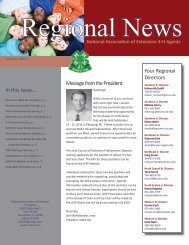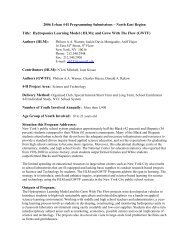Winter 2008 - Vol. 3 No. 3 - National Association of Extension 4-H ...
Winter 2008 - Vol. 3 No. 3 - National Association of Extension 4-H ...
Winter 2008 - Vol. 3 No. 3 - National Association of Extension 4-H ...
- No tags were found...
Create successful ePaper yourself
Turn your PDF publications into a flip-book with our unique Google optimized e-Paper software.
<strong>Vol</strong>ume 3, Number 3, <strong>Winter</strong> <strong>2008</strong>Article 080303RS001Informed Decision-Making in ExploratoryFactor AnalysisMelissa Cater and Krisanna MachtmesLouisiana State UniversityAbstract: As the field <strong>of</strong> youth development grows, evaluation <strong>of</strong>program outcomes has become more embedded in the programprocess. It is incumbent on youth development pr<strong>of</strong>essionals tounderstand more clearly the process <strong>of</strong> instrument development. Onephase <strong>of</strong> the process involves taking a closer look at the data todetermine if an instrument measures one overall construct or if itemscluster together to reveal underlying constructs. Exploratory factoranalysis is a technique used to determine the underlying constructs, orsubgroups, <strong>of</strong> an instrument. While pr<strong>of</strong>essionals may use a variety <strong>of</strong>decision-making steps, researchers have identified some commonlyagreed upon considerations when conducting an exploratory factoranalysis. This article seeks to make the decision-making steps <strong>of</strong> thisprocess more transparent while also <strong>of</strong>fering guidance to youthdevelopment pr<strong>of</strong>essionals who may be seeking to use this procedurefor the first time.IntroductionIn the field <strong>of</strong> youth development, evaluating programs based on participant perceptions is acommon practice. When developing instruments to measure youth perceptions, it is notuncommon to ask questions about several different aspects <strong>of</strong> learning that are targeted in aprogram. Factor analysis is a statistical technique “whose common objective is to represent aset <strong>of</strong> variables in terms <strong>of</strong> a smaller number <strong>of</strong> hypothetical variables” (Kim & Mueller, 1978, p.9). Youth development pr<strong>of</strong>essionals can use this technique to determine the underlyingconstructs, or subgroups, that an instrument measures. This is important because it allows thepr<strong>of</strong>essional to purposefully consider a specific construct (i.e., verbal communication skills), andhow this skill is impacted by a treatment or specific demographic variables, instead <strong>of</strong> simplylooking at the impact <strong>of</strong> the program on overall communication skills.






